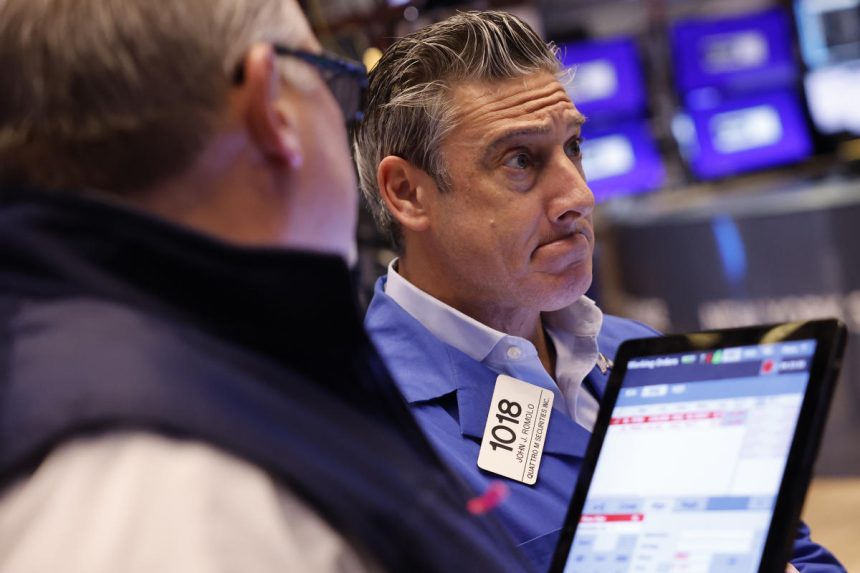Meme stocks soared again on Tuesday, as US equities broadly finished the trading day higher. The moves follow comments from President Biden on new China tariffs as investors count down to Wednesday’s heavily anticipated look into consumer prices.
The S&P 500 (^GSPC) and Dow Jones Industrial Average (^DJI) jumped about 0.5% and 0.3%, respectively. The tech-heavy Nasdaq Composite (^IXIC) climbed about 0.8% to reach a new record close of 16,511 — its first record since April 11.
President Biden spoke Tuesday afternoon about the administration’s decision to announce a new wave of tariffs across an array of Chinese goods. The White House plans to raise duties on $18 billion in Chinese imports, which include electric vehicles, steel, aluminum, semiconductors, medical devices, and more.
Meanwhile, new data on Tuesday showed wholesale prices increased 0.5% month over month in April, above the 0.3% consensus expected. That was according to the latest release of the Producer Price Index, which measures prices producers receive for goods produced. But the release also showed March’s monthly price increase was revised lower to a decrease of 0.1% from an initial reading of a 0.2% increase.
The mixed bag helped Wall Street largely shrug off the report. The more crucial reading of inflation is expected on Wednesday with the release of the Consumer Price Index.
For his part, Fed Chair Jerome Powell said Tuesday that PPI was more “mixed” than “hot,” reiterating during a question and answer session that he does not expect the central bank’s next move to be a rate hike.
In individual movers, the meme-stock train rolled on. AMC (AMC) shares surged, up as much as 120% before paring gains to close up just above 30%. GameStop (GME) also more than doubled at one point before finishing up around 60%. A rally in meme darlings has dominated the early week as the return of an influential social media star kick-started a new mania for meme stocks.
LIVE COVERAGE IS OVER11 updates
-
Meme stocks soared again on Tuesday as US equities finished the trading day higher ahead of a crucial inflation print on Wednesday.
The S&P 500 (^GSPC) and Dow Jones Industrial Average (^DJI) jumped about 0.5% and 0.3%, respectively. The tech-heavy Nasdaq Composite (^IXIC) climbed about 0.8% to reach a new record close of 16,511 — the highest level since April 11.
-
Here comes the CPI report…
Higher energy prices, fueled by an increase in gas prices, are expected to contribute to a “relatively firmer headline CPI print,” Bank of America economists Stephen Juneau and Michael Gapen wrote in a note to clients last week.
“The good news is that gasoline prices have fallen in May as geopolitical risks to higher oil prices have eased for the time being. Therefore, further increase in the near-term could be more challenged,” the economists said.
“Core” inflation, which strips out the more volatile costs of food and gas, will likely remain sticky due to higher costs of shelter and core services like insurance and medical care.
In March, the BLS noted sharp upticks in core services like motor vehicle insurance, along with motor vehicle maintenance and repair. The indexes jumped 2.6% and 1.6%, respectively, after rising just 0.9% and 0.4% in February.
But economists largely expect those trends to reverse.
“We expect motor vehicle insurance and maintenance prices to increase at a slower pace in April after both categories saw a surge in prices in March,” said Bank of America’s Juneau and Gapen.
Morgan Stanley added that, in addition to weaker car insurance inflation, disinflation trends should also improve in rents and healthcare.
“Cooling labor markets and weak data on new leases indicate further deceleration in rent inflation,” Morgan Stanley lead economist Diego Anzoategui wrote in a note to clients last week. “This and the next few months seem to be important months for rent inflation.”
“We also expect a slight deceleration in healthcare, driven by lower health insurance prices,” he said.
Read more here.
-
Areas of the market to watch ahead of CPI print
A crucial inflation report is set for release at 8:30 a.m. ET on Wednesday.
Wall Street expects the Consumer Price Index (CPI) to show prices in April increased 3.4% compared to the year prior, a slight deceleration from March’s 3.5% annual gain in prices, according to estimates from Bloomberg. Over the prior month, consumer prices are expected to have risen 0.4%, matching March’s month-over-month increase.
On a “core” basis, which strips out the more volatile costs of food and gas, prices in April are expected to have risen 3.6% over last year — a slowdown from the 3.8% annual increase seen in March, according to Bloomberg data.
Core prices are expected to have climbed 0.3% month over month in April, compared to the 0.4% increase seen in the prior month.
How the print compares to consensus estimates will be of particular focus during Wednesday’s trading day. Analyzing the day of market action back to May 2023’s CPI print, the equity research team at Goldman Sachs led by David Kostin found that “interest rate sensitive pockets of the equity market typically experience particularly large moves on CPI days regardless of the magnitude of the surprise.”
As seen in the chart below, non-profitable tech and the small-cap Russell 2000 index (^RUT) have moved significantly more depending on where the inflation print lands over the past year.
-
Oil slides amid sticky inflation data
Oil prices slid more than 1% Tuesday after sticky inflation data raised concerns that that the Federal Reserve won’t want to rush rate cuts.
“The slightly higher PPI (producer price Index) this morning is still a cautionary flag for the Fed Reserve to hold rates steady which could be a headwind for crude,” Dennis Kissler, senior vice president at BOK Financial, said in a note to clients Tuesday.
On Tuesday West Texas Intermediate (CL=F) traded below $78 per barrel. Brent (BZ=F), the international benchmark price, hovered above $82 per barrel.
Oil prices have slid in recent weeks amid an unwinding of geopolitical risks. Analysts now expect oil alliance OPEC+ to extend its production cuts beyond June.
Crude futures are up roughly 8% year to-date.
-
Biden on new China tariffs: ‘They’re cheating’
President Biden spoke Tuesday about the administration’s decision to announce a new wave of tariffs across an array of Chinese goods.
“American workers can outwork and outcompete anyone as long as the competition is fair. But for too long it hasn’t been fair,” the president said while speaking at the White House’s South Lawn.
He accused the Chinese government of “cheating” due to heavy state subsidies and “unfairly low” global market prices.
Electric vehicles are a prime focus, with duties in that category set to quadruple this year from 25% to 100%.
The “future of electric vehicles will be made in America by union workers. Period,” Biden said.
Other tariff targets include steel, aluminum, semiconductors, medical devices, and more. The administration plans to raise duties on $18 billion in Chinese imports.
The announcement comes as President Biden gears up for a rematch against his predecessor, Donald Trump.
President Joe Biden speaks in the Rose Garden of the White House in Washington, Tuesday, May 14, 2024, announcing plans to impose major new tariffs on electric vehicles, semiconductors, solar equipment, and medical supplies imported from China. (AP Photo/Susan Walsh) (ASSOCIATED PRESS) Yahoo Finance’s Ben Werschkul and Brian Sozzi have more here:
Biden’s actions notably do not include the lowering of more than $300 billion in Trump-era duties on China. Biden largely re-upped former President Donald Trump’s policy — and added new tariffs on certain sectors on top.
“The president is taking a tough, strategic approach combining investment at home with enforcement against China in key sectors,” national economic adviser Lael Brainard said ahead of the news.
Biden’s top economic aide also drew a sharp contrast with Trump’s trade record in her comments to reporters. She said Trump’s moves in office “did not deliver” and that his current 2024 campaign trail promises would spike inflation.
Most of the new tariffs announced this week could be felt quickly and are set to be implemented this year.
Others — such as new duties on semiconductors and batteries — are set to phase in more slowly in 2025 and 2026.
-
Stocks flat ahead of Biden comments
As investors awaited comments from President Biden on recently announced China tariffs, markets were little changed in afternoon trading.
The benchmark S&P 500 (^GSPC) and Dow Jones Industrial Average (^DJI) traded flat while the tech-heavy Nasdaq Composite (^IXIC) moved about 0.2% higher.
The White House plans to raise duties on $18 billion in Chinese imports and electric vehicles serving are a key focus, with duties there set to quadruple in 2024 from 25% to 100%.
-
Amazon’s cloud unit CEO Adam Selipsky to step down
Amazon (AMZN) shares slipped less than 1% on Tuesday as the company announced the CEO of its cloud computing business, Adam Selipsky, is stepping down next month.
Matt Garman, senior vice president of sales and marketing at AWS, will replace Selipsky as CEO effective June 3, the company said.
Yahoo Finance’s Hamza Shaban reports:
Selipsky’s departure comes at a high point for AWS. The cloud services unit is rapidly expanding and has reached a significant milestone of generating a $100 billion run rate. Amazon’s broader artificial intelligence strategy runs through AWS, the industry’s top cloud service by market share. During the company’s most recent earnings report, executives said cloud customers are increasingly signing up for bigger deals with longer commitments, many with generative AI components.
“Given the state of the business and the leadership team, now is an appropriate moment for me to make this transition, and to take the opportunity to spend more time with family for a while, recharge a bit, and create some mental free space to reflect and consider the possibilities,” Selipsky said. He took over AWS in 2021.
Selipsky, whose three-year tenure was defined by the pandemic, oversaw the business as companies were reeling from the disruptions of the public health crisis and pulled back from spending. But the cloud division has since posted swelling sales growth.
Last quarter revenue for AWS came in at $25 billion, beating analyst expectations and increasing about 17% compared to the same period last year.
-
Powell: Wholesale prices report wasn’t ‘hot’ but ‘mixed’
Wholesale prices rose more than expected in April, according to new data released Tuesday. However, when analyzing revisions to March’s Producer Price Index, Federal Reserve Chair Jerome Powell argued the release was “mixed.”
“We had a producer price index reading just a couple of hours ago, and I would say it’s actually quite mixed,” Powell said during a panel in Amsterdam. “You know, the headline numbers were higher, but they were backward revisions.”
He added: “I wouldn’t call it hot, I would call it sort of mixed.”
Wholesale prices increased 0.5% month over month in April, above the 0.3% consensus had expected, per the latest release of the Producer Price Index, which measures prices producers receive for goods produced.
“Core” PPI, which strips out the volatile food and energy categories, also rose 0.5%, above estimates for a 0.2% increase. Also, in the release, March’s monthly price increase was revised lower to a decrease of 0.1% from an initial reading of a 0.2% increase.
Speaking broadly about inflation, Powell said Tuesday his confidence in inflation continuing to cool is not as high as it was at the start of the year and that the central bank will need to be patient before lowering interest rates.
“We did not expect this to be a smooth road, but these [inflation readings] were higher than I think anybody expected,” Powell said. “What that has told us is that we’ll need to be patient and let restrictive policy do its work.”
-
AMC cashes in on the meme frenzy
AMC Entertainment (AMC) is cashing in on the revival of the meme stock trade.
The struggling theater chain raised $250 million of “new equity capital” through the sale of 72.5 million shares on Monday, per an SEC filing.
The completion of the equity offering, which was initially launched on March 28, came as the meme trade roared back into action on Monday. After the reemergence of Keith Gill, also known as “Roaring Kitty,” whose bull case on GameStop ignited the meme stock rally back in 2021, sent shares of GameStop (GME) soaring in early action on Monday, AMC quickly spiked in sympathy.
The stock has now more than tripled since Friday’s close, with shares up nearly 100% in Tuesday’s trading action.
AMC had been struggling since the pandemic amid a slow return to theaters from moviegoers. In the company’s most recent quarter, reported on May 8, AMC produced revenue of $951.4 million, down from $954.4 million in the same quarter a year prior. The company’s losses improved, however, with AMC producing an earnings per share loss of $0.62 in the first quarter, a narrower loss than the $1.71 seen in the same quarter a year prior.
Wedbush analyst Alicia Reese wrote in a research note on May 9 that the company was focused on “alleviating” its $4.6 billion in debt outstanding. The debt, Reese wrote, “overshadowed” any positive factors happening underneath the surface during the prior quarter.
-
Stocks little changed at open, meme stocks soar
Meme stocks soared again on Tuesday as US equities more broadly stayed muted amid a mixed inflation reading. Investors also awaited a Jerome Powell speech that could shed light on the path of interest rates.
The S&P 500 (^GSPC), Dow Jones Industrial Average (^DJI), and the tech-heavy Nasdaq Composite (^IXIC) were all little changed at the open on Tuesday.
The exciting action of the morning came in meme stocks. AMC (AMC) shares surged, up over 120%, while GameStop (GME) popped about 100% as retail investors piled in for a second day.
Trading on both stocks was halted just after the open on Tuesday.
-
Wholesale prices increased more than expected in April
Wholesale prices rose more than expected in April, furthering concerns inflation may be stickier than initially hoped and sending futures tied to the major US stock indexes lower.
Wholesale prices increased 0.5% month over month in April, above the 0.3% consensus had expected, per the latest release of the Producer Price Index, which measures prices producers receive for goods produced.
“Core” PPI, which strips out the volatile food and energy categories, also rose 0.5%, above estimates for a 0.2% increase. Also, in the release, March’s monthly price increase was revised lower to a decrease of 0.1% from an initial reading of 0.2% increase.
Futures tied to all three major averages turned lower following the news. The Dow Jones Industrial Average futures (YM=F) were lower about 0.1% after the blue-chip benchmark broke an eight-day run of gains on Monday in lackluster trading. Futures on the S&P 500 (ES=F) fell 0.2% while those tied to the the tech-heavy Nasdaq 100 (NQ=F) fell about 0.3%.
Meanwhile, the 10-year Treasury yield (^TNX) rose about 5 basis points to 4.53%.














